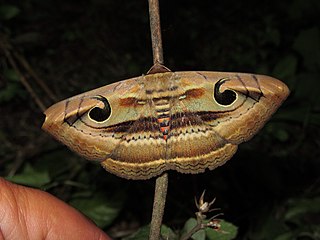
Apamea crenata, known as the clouded-bordered brindle, is a moth in the family Noctuidae. It is distributed throughout the Palearctic realm. In the North it crosses the Arctic Circle, in the Mediterranean it is found only in cool locations and mountains avoiding very hot areas. In the Alps, it rises to an altitude of about 2000 metres.

Apamea remissa, the dusky brocade, is a species of moth of the family Noctuidae. It is distributed throughout Europe and Turkey, ranging across the Palearctic realm to Siberia, Manchuria and Japan. It has also been reported from Alaska.

The Latin(Callopistria juventina) is a moth of the family Noctuidae. The species is found across the Palearctic realm.

Mesapamea secalis, the common rustic, is a moth of the family Noctuidae. The species was first described by Carl Linnaeus in his 1758 10th edition of Systema Naturae. It is found in Europe, north-west Africa, Turkey and northern Iran.

Grammodes stolida, the geometrician, is a moth of the family Erebidae. The species was first described by Johan Christian Fabricius in 1775. It is found in Africa, southern Europe, most of Asia and Australia. It migrates to central and northern Europe as far north as England, Denmark and Finland.

Grotella dis is a moth in the genus Grotella, of the family Noctuidae. The species was first described by Augustus Radcliffe Grote in 1883. This moth species is found in North America, from the Argus mts. in Kansas to North Mexico.

Acylita distincta is a species of moth of the family Noctuidae first described by E. Dukinfield Jones in 1908. It is found in Brazil. Its wingspan is about 26 mm.

Spilosoma batesi is a moth of the family Erebidae. It was described by Walter Rothschild in 1910. It is found in Nigeria, Cameroon, Congo and Zaire.

Aporophyla australis, the feathered brindle, is a moth in the family Noctuidae. The species was first described by Jean Baptiste Boisduval in 1829. It is found in western and southern Europe, North Africa and the Middle East.

Spirama retorta, the Indian owlet-moth, is a moth of the family Erebidae. The species was first described by Carl Alexander Clerck in 1764. It is found in China, Korea, Japan (Honshu), India, Nepal, Bangladesh, Thailand, Cambodia, Myanmar, Vietnam, Taiwan, Sri Lanka, Malaysia, the Philippines (Luzon), Indonesia ,Japan.

Ichneutica oliveri is a moth of the family Noctuidae. It is endemic to New Zealand, found only in the South Island. However it has not been observed on the eastern side of that island from mid-Canterbury southwards to Southland. This species is distinctive and is unlikely to be confused with other closely related species. It inhabits tussock grasslands, shrubland as well as granite sand plains, all in the alpine zone. Adults are on the wing from December to March and are attracted to light. They have been observed feeding on the flowers of Hebe species. The life history of this species is unknown as are the larval hosts.
Patissa lactealis is a moth in the family Crambidae. It was described by Cajetan Felder, Rudolf Felder and Alois Friedrich Rogenhofer in 1875. It is found in Sri Lanka.
Catephia poliochroa is a species of moth of the family Erebidae. It is found in Kenya.
Sufetula polystrialis is a moth in the family Crambidae. It was described by George Hampson in 1912. It is found on the Louisiade Islands.
Syllepte leucographalis is a moth in the family Crambidae. It was described by George Hampson in 1912. It is found in Indonesia (Bali).
Syllepte parvipuncta is a moth in the family Crambidae. It was described by George Hampson in 1912. It is found in Ghana and Sierra Leone.
Ulopeza sterictodes is a moth in the family Crambidae. It was described by George Hampson in 1912. It is found in Papua New Guinea.
Nothoploca nigripunctata is a moth in the family Drepanidae. It is found in India, Vietnam, Korea, China and the Russian Far East.
Takapsestis curvicosta is a moth in the family Drepanidae. It is found in Assam, India.
Mecistoptera albisigna is a species of moth of the family Erebidae. It was described by George Hampson in 1912. It is found in southern India, Australia and on Fiji.








